Swansong of a Modern British Cruise Ship
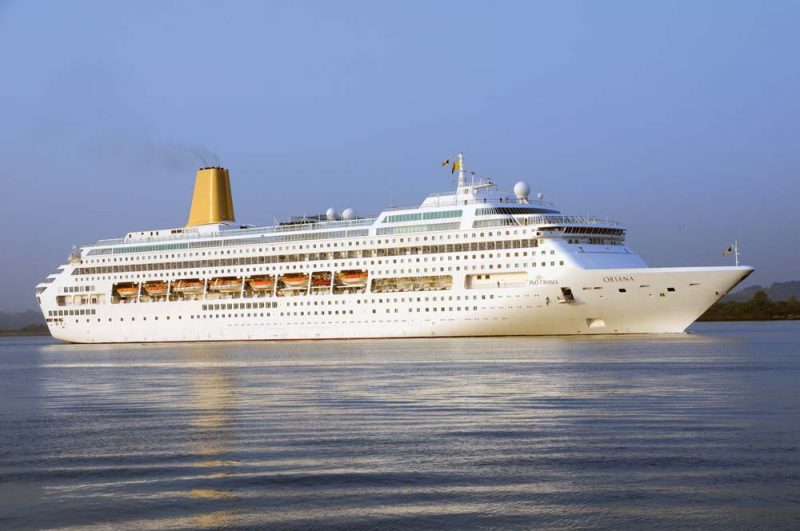
The announcement in July 2018 by P. & O. Cruises that their pivotal cruise ship Oriana, completed in Germany in 1995, would be retired in August 2019, as the company continued to modernise and expand it’s U.K. cruise programme, brought an end to 24 years of valiant worldwide cruising by the vessel. She was transferred during the same month by Carnival Cruises, the American parent company of P. & O. Cruises, from the ownership of P. & O. Cruises to a Carnival company with a view to using her in the growing Chinese cruise market for cruising the South China Sea to ports in neighbouring countries. Oriana was the first British purpose built cruise ship, and she has very much served as a benchmark for all the larger cruise ships that have followed her.
Design of Oriana
Oriana was the most traditional of the fleet of large megacruise ships owned by P. & O. Cruises, and carried 1,828 passengers on several hundred long and short cruises after she was specifically designed and purpose built for the U. K. cruise market. Robert Tillberg of Sweden and John McNeece of the U.K. were the two main designers of Oriana, and had spent a considerable time onboard the P. & O. cruise ship Canberra, completed in 1961, investigating the needs of British passengers, so as to include as many as possible of the features of Canberra into the design of Oriana. These features included an engines aft design to allow more passenger space, reduced engine noise, and with the engine fumes dissipated to the wake of the vessel.
It is worthwhile, as the design concepts of Oriana of 1995 are in many respects the same as the design of Canberra of 1961, to look at the life of the designer of the earlier cruise ship, John West. He was born on 13th August 1927 in Hebburn on Tyne and won a scholarship to Jarrow Grammar School and then studied naval architecture at King’s College in Newcastle. He joined P. & O. at the age of 25 years and two years later he became Assistant Manager in charge of technical and design work. He was promoted to be in overall charge of the design and supervision of newbuildings, with the order for the new cruise ship Canberra going to the Belfast yard of Harland and Wolff Ltd. The vessel was yard number 1621 and was launched on 16th March 1961 by Dame Patti Menzies, wife of the Australian High Commissioner in London. She cost a staggering £16 million in 1960 with the interiors of her public rooms designed by Sir Hugh Casson and hung with canvasses by a young artist named David Hockney. John West received many awards and medals for the design of Canberra and the many other ships he designed, and became a Visiting Professor to two English universities. He was a very committed Christian and lived long enough to see his beloved Canberra replaced by Oriana, and he died on 4th November 2003 at the age of 76 years.
Three interior designers for Oriana were engaged in Robert Tillberg of Sweden, John McNeece of London and Petter Yran. John McNeece and his team of designers gave the unique touches to rooms such as Anderson’s Lounge, the Knightsbridge shops, Harlequins disco and nightclub, the Pacific Lounge, the photo gallery, casino and related public spaces, as well as the onboard information graphics. Oriana has ten decks for passengers, four decks in her hull and six superstructure decks, with the Promenade Deck given an extra wide wrap around walking space, with her sixteen lifeboats being placed inboard on ‘D’ deck. The cruiser stern was tiered above to overlook the aft deck, pool and children’s play facilities. The elegant four deck high atrium and waterfall was topped by a dome of vibrant Tiffany glass, an Art Deco feature, and the central walkways leading to it gave good passenger flow. The base of the atrium consisted of a set of stairs flanked by two black painted elegant flower bouquet holders. The décor of her public walkways, shop fronts, and the corridors on each deck leading to the staterooms were restrained and conservative, and in no way ‘glitzy’.
Oriana obtained the high speed of 26.2 knots on trials with her service speed of 24.0 knots giving her the ability of keeping to schedule on long distance voyages to Australia, the destination of many of P. & O. liners of the past. Oriana holds the ‘Golden Cockerel’ trophy for the fastest ship in the P. & O. fleet, previously held by the Barrow built fleetmate of Canberra, the Oriana of 1960 with her twin ‘pepper pot’ funnels and a speed over the measured mile on trials of a fast 30.64 knots. The award passed to Canberra on the retirement of the first Oriana in 1986. The ‘Golden Cockerel’ was handed over to the new Oriana from Canberra when both ships were anchored off Cannes and each ship sent boats over to perform the handover ceremony. Oriana of 1960 had a very successful maiden voyage out to Australia after sailing from Southampton on 3rd December 1960. She then moved to the Transpacific service from Sydney (NSW) to Auckland and then under the Lion’s Gate Bridge at Vancouver before finishing at San Francisco.
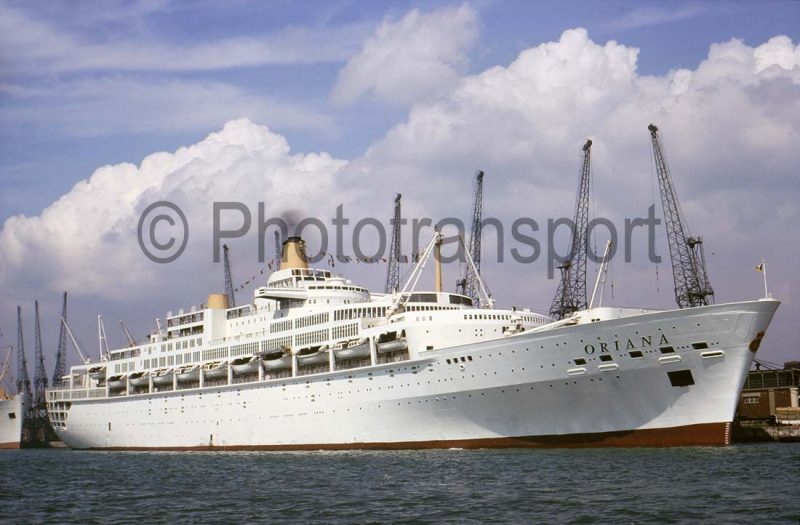
Oriana is powered by four M.A.N.-B & W L58/64 diesel engines of 47,750 kW combined capacity driving two controllable pitch propellers through two Renk-Tacke gearboxes. The gearboxes are coupled to engines via Vulkan-Rato couplings. The diesel engines comprise two nine cylinder centre engines and two six cylinder wing engines built at Augsburg with a total power of 54,040 bhp. This type of wing engine arrangement gives flexibility in the amount of power transferred through to the propellers, and thus control of fuel consumption. The propulsion system also integrates three bow thrusters, one stern thruster and two rudders. Oriana has very large stabilisers for the comfort of passengers, these covering a surface area of 21.5 square metres and reduce the rolling motion by 90% at a speed of nineteen knots. Two auxiliary steam boilers for heating and ancillary equipment use, four M.A.N.-B & W 6L40/54 generators to provide electrical power, and other pumps and equipment completed the engine room outfit, with compartments in the double bottom and alongside the engine room containing 2,400 tonnes of fuel oil bunkers.
P & O. would have wanted a British yard such as Harland and Wolff Ltd. of Belfast to build the ship, but fitting out such an important ship was problematic in a British yard, so the order went to the Meyer Werft yard at Papenburg in Lower Saxony in Germany. Construction in the large Building Hall was by a series of 500 tonne prefabricated sections, with her funnel and forward navigation mast fitted alongside the fitting out quay.
The single funnel was designed to look like the twin elegant funnels of Canberra, the basic design of both vessels being very similar with lifeboats being carried at the same deck level. She was laid down on 11th March 1993 and launched on 30th June 1994, making the slow two day passage down the river Ems to the sea when fitted out by March 1995. She was named by H. M. The Queen on 6th April 1995 at Ocean Dock in Southampton, and was towed stern first dressed overall with flags to the Western Docks two days later, passing Canberra, which was about to sail on a cruise and was also dressed overall with flags.
Oriana has an overall length of 853.02 feet (260.0 metres) with a moulded beam of 105.64 feet (32.2 metres) and a loaded draft of 25.92 feet (7.90 metres), and is equipped with forward and stern thrusters for manoeuvrability in port. Oriana was designed to have accommodation for 1,828 passengers on a cabin capacity basis of two passengers, with a total of 914 cabins (594 outside and 320 inside) with 112 single cabins, 118 balcony cabins on one deck, and eight cabins reserved for wheelchair passengers.
The Balcony Deck is on ‘B’ deck and comprises the most spacious and elegant Suites, Mini Suites and Deluxe Balcony staterooms sleeping up to four persons, with the other outside and inside staterooms normally for two person occupancy. The gross tonnage worked out at 69,153 with a net tonnage of 36,829, and she carries a crew of 794, with British officers and international stewards and dining staff. Oriana cost the expensive amount of over £200 million to build, and her name refers to Queen Elizabeth I, in the same way that Gloriana was used to refer to her in poetry.
Public Rooms of Oriana
The exemplary public rooms and facilities onboard comprise three outdoor swimming pools, the Oasis Health and Spa Club, a casino, three main Dining Room choices plus two speciality restaurants and two other dining options, and six entertainment choices, and other multi-purpose rooms. These are:-
Swimming and Health
Riviera Pool is situated forward on Lido Deck with the pool surrounded by a bandstand, two whirlpools, a bar and many sun loungers. A raised walkway above on Sun Deck extends around both sides of the ship for walking and jogging exercise.
Crystal Pool is further aft on Lido Deck, and at one end of the pool is a bronze sculpture by Andre Wallace of a man in a boat beside a reclining woman in another boat.
Terrace Pool is at the stern of the vessel on ‘D’ deck and has its own whirlpool. The open decks of Oriana feature a sports court, golf nets, shuffleboard and teak wooden promenades.
Oasis Health and Spa Club was originally run by Champneys and is located high on Lido Deck towards the bow of the vessel, offering massages, facials, and health and slimming treatment. The Spa also has a whirlpool, thermal chairs, steam rooms and saunas.
The Fitness Centre is within the Spa and runs exercise classes, personal training, with many exercise machines, free weights, treadmills, bicycle exercisers, and other equipment, with also an area for aerobics. The Salon is also in the Spa and offers hair styling, barber shop, make-up and manicures.
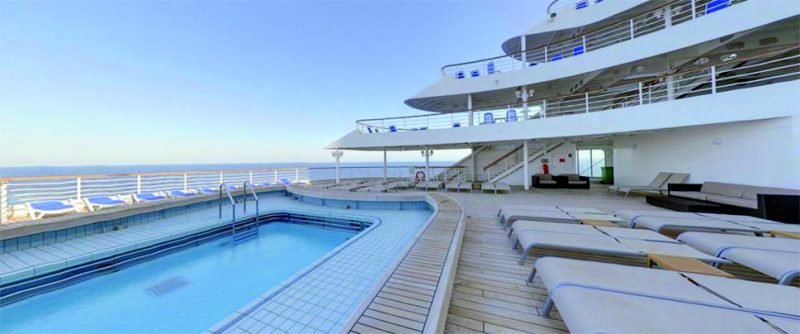
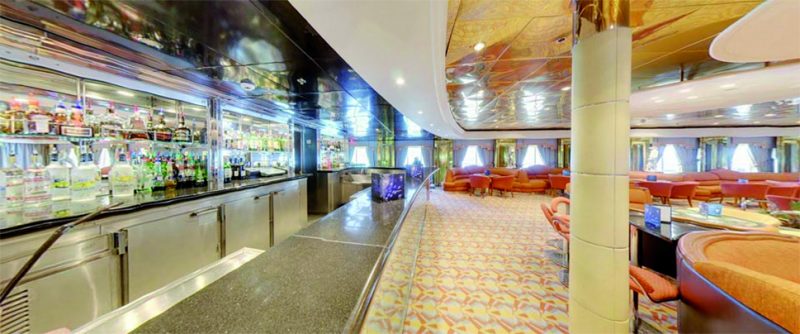
Entertainment
Theatre Royal with 664 seats is the largest entertainment venue with well known guest entertainers as well as productions by the ship’s own entertainers. The theatre was designed by John Wyckham and is decorated in rich red plush seats, curtains and fittings to give the feel of a West End theatre with high technology audio and lighting equipment to give good acoustics plus a revolving stage and orchestra pit. The seats are individually air conditioned to give guests a memorable experience in a very beautiful theatre.
Chaplin’s Cinema seats 189 and shows both classic and recent film releases, with the room also used for lectures and talks on Promenade Deck.
Harlequin’s Disco and Nightclub seats 230 has a very large dance floor for both daytime ballroom dancing and a late night disco dancing on Promenade Deck.
Pacific Lounge seats 430 and is located at the aft end of the Promenade Deck, and in the evenings hosts cabaret with stand-up comedians, magicians, British singers and acts, and musical performances. There is a full service bar, and it is also used during the daytime for a range of classes and activities.
Curzon Room named after Lord Curzon of India fame hosted classical music concerts and sessions for 140 guests, but was replaced in the 2006 refit at Bremerhaven costing £12 million of the ship by the new Oriana Rhodes restaurant for 96 diners designed by chef Gary Rhodes, after the success of the Arcadian Rhodes restaurant on her fleetmate Arcadia.
Oriana was re-registered at Bermuda at the time of the refit so that weddings could be held by her Master at sea.
Monte Carlo Casino is an intimate club style casino offering roulette, card and other games, with the gaming tables hosted by professional croupiers, and the room is also surrounded by slot machines.
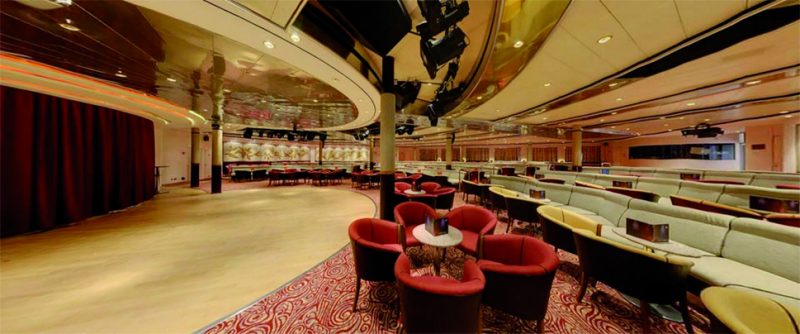
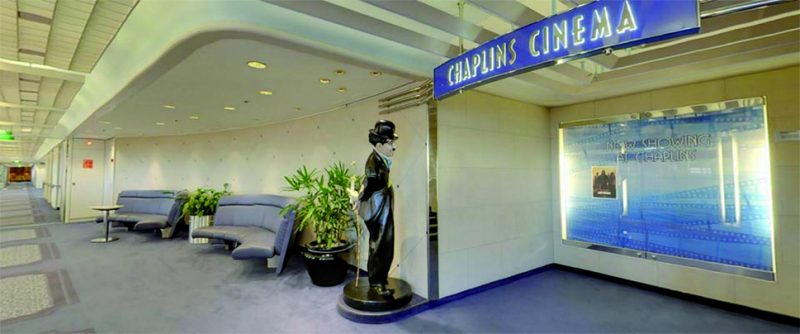
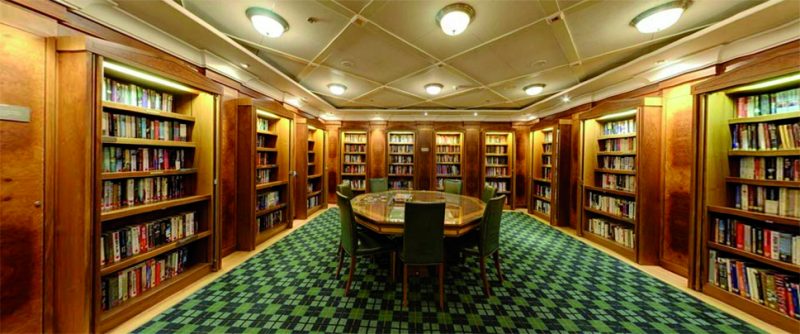
Dining
Peninsular Restaurant is ‘midships on ‘E’ deck and, as with the very similar Oriental Restaurant aft on the same deck, seats are allocated according to cabin grade and chosen cabin. It seats 524 and offers open seating breakfast, lunch and dinner, the latter being limited to passengers who have opted for P. & O. Cruises flexible dining system who can arrive at any time. There are tables for two, four, six and eight, with excellent decorated treatment of the ceilings, chandeliers and décor with Art Deco touches.
Oriental Restaurant is the same size as the Peninsular Restaurant but seats 454 and has fabulous views over the stern and wake of the vessel, with windows on three sides, and is usually open only for dinner with passengers assigned to a specific table according to cabin grade and chosen cabin for either the first or second sitting. The menu includes signature dishes by Anton Mosimann for this excellent and much recommended dining experience.
Conservatory Buffet Café is a self service buffet restaurant with plenty of natural light through full length windows on each side, and offers good panoramic views over the sea. It is open throughout the day and well into the evening as the third major restaurant on the ship, serving continental breakfasts, afternoon luncheons and snacks, to themed evening buffet dinners. The beverage stands are also self service but this does not detract for many passengers who enjoy a more casual ambience. Al Fresco Dining space is located forward of the Riviera Pool and offers self service Mediterranean outdoor dishes on its full menu.
Tiffany Court offers light snacks and pastries and is located next to the Tiffany glass ceiling of the magnificent atrium.
Sindhu Indian Restaurant is a speciality restaurant that was introduced after the ship had been in service for a number of years at the request of passengers who wanted a wider choice of food. The Indian cuisine was developed in co-operation with celebrity chef Atul Kochhar and is located ‘midships on ‘D’ deck near the atrium, with a cover charge payable on entering.
Beach House Buffet is another speciality restaurant in a section of the Conservatory Buffet Café for evening dining. This a very relaxed dining option offering a wide range of grilled meals and with panoramic views of the sea.
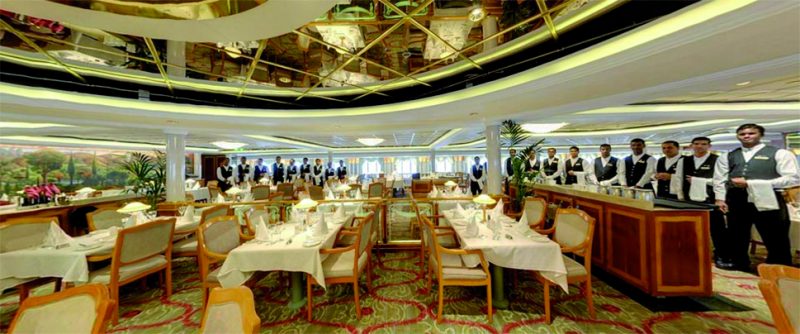
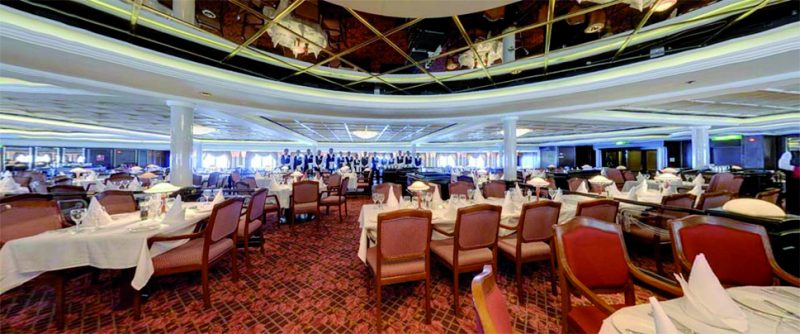
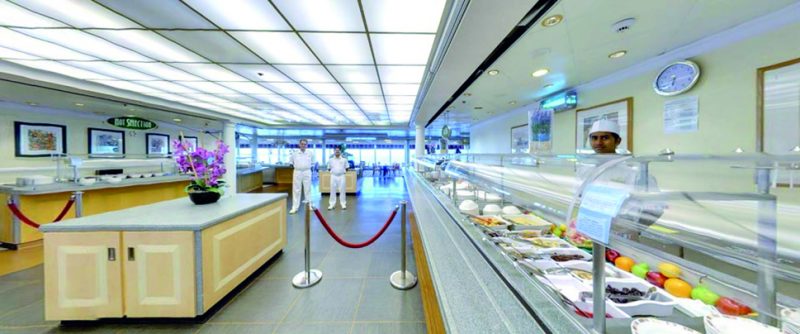
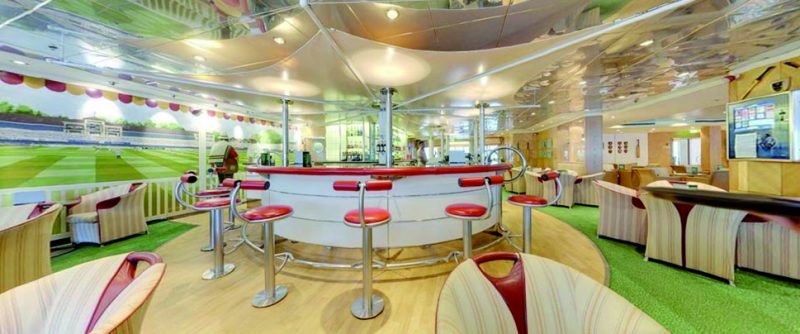
Shops, Children’s Rooms And Library
Knightsbridge Shops are located in a curved area and row on Promenade Deck near the atrium, and offer everything from expensive, high end jewellery to more modest priced fragrances, fridge magnets, duty free liquor and tobacco. The Photo Gallery is nearby, as is the Plaque Room where many plaques and treasured mementos have been placed after being gifted by Ambassadors and leaders of the many countries that Oriana has visited during the last 24 years.
The Library is a beautiful light brown wood panelled room with ten bookcases filled with hardback books, two reading tables, comfortable armchairs, reading lamps and a lectern, and was designed by Viscount Linley. There are also the usual bridge, chess, and backgammon for serious players of these games, and the cyber study has fast wi-fi and Internet access with again beautiful wooden armchairs. This room is a joy for all serious readers to while away a few hours on a long day at sea with no port calls.

Children’s Rooms include the Decibels teenage disco with very loud music, as well as indoor and outdoor facilities for the younger children. The rooms were refurbished during the 2006 refit, and then converted in 2011 to cabins during her transformation to an adult only cruise ship.
Multi-Purpose Rooms
Thackeray Writing Room is a traditional writing room lit by lamps on each table and with relaxing furniture and armchairs, and was also designed by Viscount Linley. The room is named in honour of author William Thackeray (1811-1863), a P. & O. passenger during the early days of the company in 1844 and who wrote many books and magazine articles.
Crichton’s Room is used for card games, board games e.g. bridge, chess and backgammon tournaments, as well as evening quizzes and is named after the former P. & O. director Sir Andrew Crichton.
Medina Room is located next to the Crow’s Nest bar on Sun Deck and is used for multi-purpose meetings and other uses.
Bars And Lounges
Observation Lounge and Crow’s Nest offers high panoramic views over the bow of Oriana as well as a good selection of live music.
Anderson’s is a gentleman’s club featuring a big selection of 19th century maritime paintings and artefacts and is named in honour of the founder of the company, Arthur Anderson. This is a very popular lounge and bar but surprisingly it has no welcoming fireplace for gentlemen to feel at home.
Lord’s Tavern is a sports themed lounge and bar that recalls the home of cricket and is decorated with cricketing memorabilia. It has video screens around the outside of the room for viewing football matches and other sporting events. This room was the individual work of John McNeece, whose home in London stands on the original site of Lord’s cricket ground. The tavern was refurbished and extended during the 2006 refit of the ship, and revels in being literally festooned with cricket memorabilia to the delight of cricket fans.
Tiffany’s is located at the top of the atrium underneath the large dome of Tiffany glass, with a baby grand piano and live music to relax in the evenings.
Terrace Bar or Sunset Bar overlooks the stern beside the Terrace Pool and on the starboard side aft on ‘D’ deck.
Riviera Bar overlooks the Riviera Pool on Lido Deck, and is very popular throughout the long daylight hours of a day at sea.
Cabins and Staterooms
Oriana now has nine cabin and stateroom categories varying vastly in price, but all are well equipped, with families catered for by 110 inside and outside cabins that can be converted to sleep four persons. There are a number of cabins for single occupancy at an additional supplement to the normal cabin rates. Once the limit is reached, additional unsold cabins may be offered but at an increased price. Large suites, mini suites and deluxe Balcony staterooms come with butler service, with suites having spacious accommodation of around 500 square feet in area with a separate lounge and dressing area separated by glazed partitions, superior bathroom with private whirlpool bath to give discerning passengers the ‘VIP Treatment’. All cabins have TV, radio, telephone, hair dryer, refrigerator, safe, tea/coffee makers, air conditioning, writing desk and chair, and wardrobe and drawer space. All grades of cabin have relaxing décor in many pastel shades to give guests the maximum of comfort, and were restyled with new colour schemes and interiors during the December 2006 refit costing £12 million.
The Long Years In Service
The trials of Oriana in the rough winter and March weather of the North Sea did not go that well, as the ship was plagued by vibration due to cavitation of her propulsion system, as her Master Ian Gibb, Commodore of P. & O. Cruises, relates in his article following this. This was only finally solved by the fitting of two new propellers in a Southampton dry dock in early 1996, but even this dry docking was delayed by high winds that prevented her from entering dry dock just prior to her World Cruise of 1996. The first port of call was on 12th April 1995 at Funchal on Madeira, with the long outer breakwater at the port often later shared with fleetmates Aurora, Arcadia and Adonia. Oriana made her first call at Gibraltar in June of 1995 on a Western Mediterranean cruise, and in addition to her annual World Cruise from January to the end of March each year, she offered Baltic, North Cape of Norway, Western and Eastern Mediterranean, Caribbean, and Canaries, Madeira and Azores cruises. Port calls at Copenhagen and Gdynia on a Baltic cruise, might be followed by calls at Gibraltar, Palma (Majorca), Valletta and Cannes on Mediterranean cruises, and then by calls at Arrecife on Lanzarote to visit Timanfaya volcanic park, Puerto del Rosario on Fuerteventura with its classic windmills, Santa Cruz de Tenerife, Las Palmas de Gran Canaria, San Sebastian on La Gomera, Santa Cruz de La Palma on the green island of La Palma, as well as passing the smaller western Canarian islands. The Azores islands and ports of Horta, Fayal, Praia de Vitoria and Ponta Delgada might be called at on Transatlantic and Caribbean cruises.
In September 1997, the arrivals and departures of Oriana on cruises at Southampton passed the sad sight of Canberra de-storing and out of commission at Berth 101, Western Docks. The classic furniture and valuable effects of Canberra were moved to storage, but her bedding, sheets and other unwanted material were unceremoniously thrown into a barge on her outboard side for disposal. Canberra sailed from Southampton on 10th October 1997 for the breaking up beaches at Gadani Beach and was run aground at her maximum full speed in order to reach the upper parts of the beach breaking up facility. Canberra is, of course, remembered as the heroine of the Falklands War campaign as a trooper, prisoner of war ship and hospital ship. She took 2,500 troops herself to the Falklands, and then made the short hop to South Georgia to collect the other 2,500 troops that QE2 had brought, the QE2 being considered too valuable to risk in the waters off the Falklands.
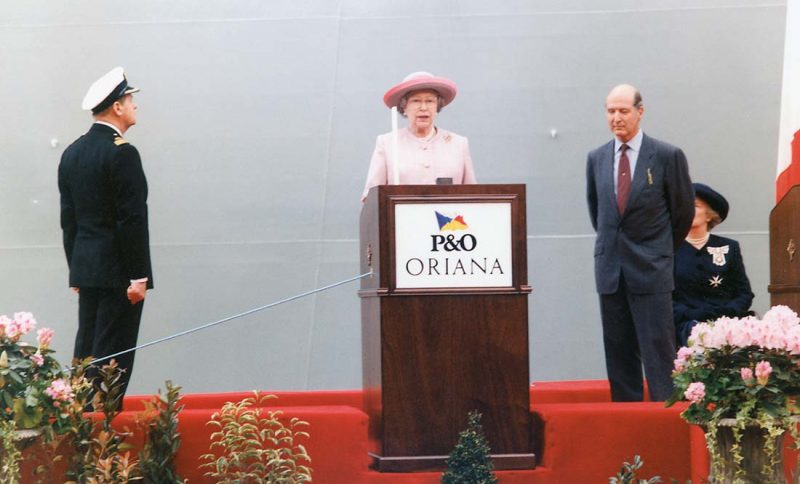
Oriana arrived back from Madeira at Southampton on 14th April 1999 and after discharging her passengers went off service for a short refit before commencing her wide range of cruises outlined above during that year. Oriana and fleetmate Arcadia offered two World Cruises between January and April 1998, following the transfer of Star Princess from North American subsidiary Princess Cruises and her renaming as Arcadia. Oriana sailed on her World Cruise from Southampton on 6th January 1998 on a westabout route calling at Caribbean ports, a transit of the Panama Canal, West Coast ports of the U.S.A. and Canada, Honolulu on Hawaii, New Zealand, Australia, Far East, South East Asia, the Persian Gulf, Red Sea, Suez Canal and Mediterranean returning from her ninety day global voyage to her home port on 7th April. During this voyage, both Oriana and Queen Elizabeth 2 embarked British Government staff at Hong Kong in March for repatriation to the mother country.
The Millennium year cruise schedule of Oriana offered three really special cruises of seven nights, with the first cruise westwards from Southampton to New York, followed by a seven night special charter out of New York and returning to that port, followed by a seven night eastwards cruise back to Southampton. On this eastwards cruise, Oriana was hit by a fifty feet high rogue wave on her port side on 29th September, smashing cabin windows and sending seawater pouring down three decks through the main central staircase, the forward and aft staircases being unaffected. Three passengers and an officer were cut by flying glass and six cabins were flooded. Oriana turned around to a westerly direction so that emergency repairs could be made in the lee of the wind. The injured were treated in the ship’s hospital and four others were treated for shock. The top of the wave reached above ‘E’ deck with diners in both the Peninsular and Oriental Restaurants somewhat frightened by the experience. Oriana continued her voyage at a lower speed, and docked at Southampton more than eighteen hours late, and her next Mediterranean cruise was delayed. Cruise ships have big windows and balconies and can be easily damaged by severe gales and freak waves.
The new near sister and fleetmate of Oriana, Aurora, arrived in Southampton in April 2000 from the building yard at Papenburg to take her place in the British cruising market. She was ten metres longer than Oriana and differed in having a ‘ducktail’ stern beneath her tiers of passenger decks, and was named after the Goddess of the Dawn. As with Oriana, she sailed down the river Ems from the Meyer Werft shipyard to the sea at Emden and took two high tides for the complete journey, tying up halfway down at low water.
Oriana and Aurora provided a fine cruising experience for British cruise passengers in the usual cruising areas of the Mediterranean, the Canaries, Madeira and the Baltic Sea, as well as both sailing early in each New Year on a long 100 day Round the World Cruise via the Pacific and Australasia. In the summer of 2002, P. & O. Princess Cruises (formed in mid 1974 by the purchase of Princess Cruises of California) announced that a new British cruising subsidiary was to be set up with cruises based at Palma (Majorca) as Ocean Village Cruising. Arcadia, the former Star Princess completed in 1989, was based at Palma from May 2003 as Ocean Village for a younger cruising market, and the replacement for Arcadia in the P. & O. Cruises British market from Southampton was Adonia, the former Sea Princess completed in November 1998. The Ocean Village cruise brand was discontinued during 2009/10.
On 18th April 2003, an extraordinary A.G.M. of P. & O. voted 99.7% in favour of a takeover bid for P. & O. Princess Cruises by Carnival Cruises of Miami, headed by Micky Arison and his family. An enlarged Carnival Cruises fleet of 66 ships with 100,000 cruise berths was created with a further seventeen cruise ships on order. The deal included the British cruise fleet of Oriana, Aurora, Adonia, Oceana, the former Ocean Princess completed in January 2000, and Victoria, the former Kungsholm completed at Clydebank in 1966 and on charter to Holiday Kruzfahrten as Mona Lisa.
Oriana sailed from Southampton on 8th January 2006 on her annual Round the World cruise, but a few days later some of her passengers were affected by the Novovirus stomach bug. She was allowed to dock at Piraeus on 19th January 2006, the same port that had denied access to fleetmate Aurora in November 2003 with the same Novovirus bug. The large number of ports on the tight schedule of Oriana was not affected by the outbreak, and after transitting the Suez Canal on schedule she completed the remainder of the cruise without incident and arrived back at Southampton on 18th April 2006. Unfortunately, Oriana also suffered from occasional bouts of novovirus stomach bug outbreaks during the years from 2010 to 2014.
Oriana arrived back from her Round the World cruise in April 2008, passing in port the new P. & O. Cruises flagship Ventura, which had arrived on 6th April 2008 from the Monfalcone yard of Fincantieri. Ventura has fifteen decks for the amenities of her 3,092 passengers at full cabin occupancy, and a crew of 1,200 with no fewer than seven thousand works of art on display, eight restaurants, six shops, five swimming pools and three show lounges. She has 1,550 passenger cabins of which almost 900 have balconies, and was named by Dame Helen Mirren on 16th April and left on her first P. & O. Cruise two days later. The P. & O. Cruises British fleet was then composed of six ships in Oriana, her near sister Aurora, Ventura, Oceana, Artemis (the former Royal Princess of 1984 that had joined P. & O. Cruises in May 2005), and Arcadia, the latter completed in April 2005 by the Monfacone yard of Fincantieri, which had at first been intended for the other Carnival Cruises British subsidiary of Cunard Line as Queen Victoria.
The new Azura of similar size to Ventura of 2008, arrived at Southampton for the first time on 7th April 2010 from the Monfalcone yard of Fincantieri and sailed on her first P. & O. Cruise five days later. The P. & O. Cruises fleet was now seven ships with Oriana, her near sister Aurora, Artemis, Oceana, Ventura, Azura and Arcadia.
Artemis sailed on her final P. & O. cruise on 12th April 2011 with a good send off with a firework display and exchanges of sirens with all vessels in port. The last cruise of Artemis was sold out within fourteen minutes after becoming available.
The year of 2010 saw the three ‘A’ cruise ships of Arcadia of 2005, Artemis of 1984 and Aurora of 2000 depart in January on their Round the World cruises. Artemis was on her last world cruise before delivery to Phoenix Seereisen as their Artania. Oriana, on the other hand, sailed on her annual Round the World cruise at the end of September 2010 instead of in early January. She had onboard 1,710 passengers, of whom one third did the full 84 day cruise and half of the remainder did the long cruise from the U.K. to Australia. Oriana arrived home from a very successful world cruise a few days before Christmas, her ports of call having been Funchal (Madeira), Castries (St. Lucia), Margarita Island, Curacao, Panama Canal transit, Acapulco, San Francisco, Honolulu, Apia, Auckland, Wellington, Sydney (NSW), Brisbane, Whitsunday Islands, Cairns, Manila, Hong Kong, Phu My, Bangkok, Ko Samui, Singapore, Port Kelang, Mumbai, Sharm el Sheik, Suez Canal, Port Said, Piraeus, Lisbon and home to Southampton. She entered Sydney Harbour with a twenty metre long ‘moustache’ painted below her navigating bridge in support of Movember, a movement raising funds in support of prostate cancer in men. The lunch onboard that day was in honour of a reunion of ten of the 1961 Australian cricket team, who were the last to travel by ship to an England Ashes Series, all subsequent teams flying to Heathrow.
At the start of 2011, Oriana made a fifty day cruise to the Caribbean with a transit of the Panama Canal and arrived back at Southampton on 20th March 2011. She then made fifteen shorter cruises throughout the year to the Mediterranean, Baltic and North Cape of Norway ending with a thirty day cruise during October to the Caribbean and the U.S.A. calling at Funchal (Madeira), St. Maarten, Tortola, Jamaica, Grand Cayman, Cozumel, New Orleans, Key West, Fort Lauderdale, Charleston (SC), Ponta Delgada (Azores) and arrived back at Southampton on 31st October 2011. Oriana then made a sixteen day cruise to the Western and Eastern Mediterranean, before being refitted with 27 new cabins on ‘D’ deck aft, and being fitted with a ‘ducktail’ stern during a month long refit at the Blohm and Voss shipyard in Hamburg, with her children’s play areas converted to cabins and with the addition of the new Ocean Grill restaurant and a second Italian Sorrento restaurant with an outdoor dining area. Oriana was then classed as an adult only ship, alongside the similarly classed Adonia.
Oriana made her last Round the World cruise in 2012, sailing from Southampton on the last day of 2011 on a 97 night cruise and calling at Gibraltar, Leixoes (Oporto), Tripoli (Libya), Suez Canal transit, Sharm el Sheik, Muscat (Oman), Dubai, Mumbai, Cochin, Port Kelang, Singapore, Phu My (Vietnam), Nha Trang (Vietnam), Hong Kong, Bandar Seri Begawan (Brunei), Bali, Darwin, Whitsunday Islands, Brisbane, Sydney (NSW), Milford Sound (New Zealand), Christchurch, Wellington, Auckland, Bora Bora (French Polynesia), Papeete (French Polynesia), Honolulu, San Francisco, Acapulco, Huatulco (Mexico), Panama Canal transit, Curacao, Margarita Island, Bridgetown (Barbados), Funchal and arrived back at Southampton on 10th April 2012. Oriana had been escorted on the first leg of this voyage by RFA Wave Knight while transitting the Gulf of Aden due to potential pirate activity in the area. She then made eight shorter European cruises before she arrived at Southampton on 3rd July 2012.
The 175th Anniversary of P. & O. was celebrated in great pride and style during July and August 2012, with all of their distinguished worldwide fleet still flying the diagonal quartered houseflag of blue, red, yellow and white adopted by Brodie Wilcox and Arthur Anderson from the royal flags of Spain and Portugal. A grand parade of seven P. & O. cruise ships in torrential rain took place from Southampton on 3rd July 2012 by Oriana, Aurora, Arcadia, Ventura, Azura, Adonia and Oceana with a combined gross tonnage of 569,000 tonnes.
Adonia was the lead cruise ship sailing from Southampton at 1715 hours and was then followed by Ventura, Arcadia, Aurora, Oriana, Azura and Oceana in line astern. A flotilla of craft followed the seven ships down Southampton Water and, once past Cowes, the line of seven ships split into two columns to pass port and starboard of Patricia of Trinity House with H.R.H. The Princess Royal onboard, godmother to two P. & O. Cruises ships. The ships then resumed their line astern formation and dispersed when clear of Nab Tower bound for the Mediterranean, Baltic, Scandinavia and the Canary Islands. There were many vantage points to watch the Grand Parade on both Southampton Water and the Solent with an estimate of 10,000 spectators rewarded after standing for hours in torrential rain. Adonia had been built as the smaller cruise ship R8 for Renaissance Cruises, becoming Minerva II in 2003, Royal Princess in 2007, and Adonia in 2011. She made her last cruise for P. & O. when she sailed from Bridgetown (Barbados) on 23rd February 2018, returning to the same port on 9th March after a fourteen day cruise, and was sold to Azamara Cruises of the Royal Caribbean International (RCI) stable.
Oriana sailed after the Grand Parade on 3rd July 2012 on a three day cruise to Zeebrugge and Amsterdam, followed by a five day cruise to Stavanger, Geirangerfjord, and Bergen, an eight day cruise to Stavanger, Alesund, Trondheim, Ny Alesund, Tromso, Bergen and Eidfjord, a five day cruise to Bergen, Andalsnes, Olden and Stavanger, two eight day Baltic Capitals cruises, an eight day cruise to Iceland and Norway, a six day cruise to Madeira and the Canary Islands, and a Transatlantic and Caribbean cruise calling at Ponta Delgada, Antigua, Tortola, St. Maarten, St. Lucia, Barbados and Funchal on the return leg. An interesting twenty five day cruise to the Eastern Mediterranean ports, with guest lecturers on Greek antiquaries onboard, included Aqaba (Jordan), Sharm el Sheik (Egypt), Safaga (Egypt), Suez Canal transit, Limassol, Haifa, Rhodes, Istanbul, Piraeus, Katakolon (Greece), Malaga and then returned to Southampton on 16th November 2012. She ended the year with a Canaries, Lisbon and Valencia cruise, a cruise to Zeebrugge, Amsterdam, Copenhagen, Oslo and Hamburg, and lastly a cruise to Leixoes, Malaga, Valletta, Limassol, Ashdod, Port Said, Piraeus, Katakolon (Greece), Messina (Italy), Gibraltar and home to Southampton.

Oriana made a total of twenty five cruises during 2013, the longest was a thirty five day Eastern Mediterranean cruise calling at Cadiz, Valletta, Alexandria, Port Said, Limassol, Haifa, Ashdod, Kusadasi (for Ephesus), Piraeus, Katakolon (Greece), Messina, Valencia, Lisbon and home to Southampton. Later in the year she made an equally long thirty five day cruise to the Caribbean and the U.S.A. calling at Funchal, Castries (St. Lucia), St. John’s (Antigua), Tortola (Virgin Islands), Montego Bay (Jamaica), Cozumel, New Orleans, Key West, Fort Lauderdale, Port Canaveral, Charleston (SC), Ponta Delgada (Azores) and home to Southampton.
Oriana suffered a propulsion system fault shortly after sailing from Southampton on 15th February 2014 on a Canary Islands cruise. She was due at La Palma on 20th February but was diverted to Funchal on Madeira for an inspection. The decision was then made to return to Southampton for repairs. She had a full list of passengers, who were given the option of staying onboard at Southampton for the duration of the fourteen night cruise until 1st March. They were offered a 40% cash refund or a credit for 100% of a following cruise in 2014 or 2015. Oriana was due to sail on 1st March for Stavanger but this was also delayed until 0430 hours the next morning, but she made up the time in the North Sea by sailing at speeds of up to 27.5 knots. She made a total of twenty five cruises during that year of 2014.
‘Union Flag’ Livery
The eight P. & O. cruise ships were painted in a new, bold ‘Union Flag’ livery with a union jack on their upper bow, and received a blue funnel carrying an illuminated rising sun motif. The latter was for the ‘Oriental’ part of the Peninsular and Oriental (P. & O.) name on the company’s coat of arms. Aurora, near sister of Oriana, had been the first in the fleet to receive the new look at the end of 2014, followed by Oriana with a blue funnel at the turn of the year whilst on a cruise and then gained her painted bow flag at Southampton, and by the new flagship Britannia in March 2015 on her arrival from the Monfalcone yard of Fincantieri.
The new twin funnelled flagship has accommodation for 3,611 passengers and combines the classic good looks of Oriana and Aurora with the sweeping lines of the larger Ventura and Azura. The ‘Union Flag’ livery of the new flagship had consumed almost six hundred litres of paint. The remainder of the fleet received their new livery during 2015 and the first months of 2016.
Oriana reported a fire in her engine room on 19th April 2015 shortly after sailing from the Port of Miami for Key West at 0820 hours. The U.S. Coastguard communications with the ship included requests from Oriana for tugs to assist it back into port. Oriana was on a 32 day cruise to Bermuda and the Eastern Seaboard of the U.S.A., and had sailed from Southampton to call at Ponta Delgada (Azores), Hamilton (Bermuda), Charleston (SC), Jacksonville, Port Canaveral, Miami, Key West, New Orleans, Nassau, Horta (Azores) and home to Southampton. Oriana was inactive during a twenty day refit from 26th November 2015 until 15th December at the Blohm and Voss yard in Hamburg, repairs included the unjamming of her ship’s whistle.
Oriana made a fifty day cruise to the Caribbean and the U.S.A. during 2016 calling at Santa Cruz de Tenerife, Bridgetown (Barbados), Pointe a Pitre (Guadeloupe), St. John’s (Antigua), Castries (St. Lucia), Curacao, Oranjestad (Aruba), Cartagena (Colombia), Puerto Limon (Costa Rica), Roatan (Honduras), Santo Tomas de Castilla (Guatemala), Costa Maya (Mexico), Prospero (Mexico), New Orleans, Key West, Miami, Port Canaveral, Charleston (SC), Hamilton (Bermuda), Funchal and home to Southampton. The post-refit cruise of Oriana after maintenance and repairs was a 2016 Christmas and New Year cruise under the command of Capt. David Box.
Oriana made a spectacular fifty day cruise to the Caribbean and the Amazon during early 2017 calling at Praia de Vitoria on Terceira (Azores) instead of Ponta Delgada on Sao Miguel (Azores) due to bad weather, Hamilton (Bermuda), Port Everglades, Key West, New Orleans, Progreso (Mexico), Montego Bay (Jamaica), Amber Cove (Dominican Republic), Pointe a Pitre (Guadeloupe), St. Vincent and the Grenadines, Bridgetown (Barbados), Tobago, Manaus (Brazil), Parintins (Brazil), Santarem (Brazil), Cape Verde Islands, Santa Cruz de Tenerife and home to Southampton. The six day 1,500 nautical mile transit of the Amazon from the wide delta to the former rubber exporting port of Manaus was a truly memorable experience. This cruise of more than 14,000 nautical miles had visited seventeen ports in thirteen countries, with the call at Progreso in Mexico allowing passengers to view the extensive nearby Mayan cities and temples of Uxmal and Chichen Itza.
Oriana was out of service for a 22 day maintenance refit from 7th January 2018 at the Blohm and Voss yard at Hamburg, with her fifty night cruise to the Caribbean and the U.S.A. cancelled. On her fourth cruise after returning to service, she made a voyage in search of the Northern Lights to the Norwegian ports of Stavanger, Tromso, Alta and Andalsnes. The greenish hues flashing across and illuminating the skies of Northern Norway are another spectacular and long remembered sight. Oriana finished the year with a twenty eight cruise to the Azores and the Caribbean that departed from Southampton on 11th November 2018. Oriana made more visits to Funchal on Madeira than any other port during the year, with the wooden replica of the Santa Maria flagship of Columbus (Colon) sometimes passing alongside Oriana moored at the breakwater at the Madeiran port.
Postscript
The unscheduled arrival of Oriana at the Hamburg yard of Blohm and Voss in January 2018 for three weeks of maintenance came amid rumours about her future, as she is more costly to operate as the ‘grand lady’ of the fleet. The position was made clear by the July 2018 announcement that Oriana will be retired on 9th August 2019 at the end of a last eighteen day cruise to Norway and the North Cape. The final port of call will be Belfast on 7th August, birthplace of Canberra, and two days later she will return for the last time up Southampton Water. Aurora, her near and newer sister, will become an adult only ship from 8th April 2019, and thus take the place of Oriana alongside the other adult only cruise ship, Arcadia of 2005. All passengers booked on Oriana cruises departing after August 2019 had been contacted by telephone or by E-mail to arrange an alternative cruise.
The ownership of Oriana was transferred by Carnival Cruises to Oriental Fleet Cruise 01 Ltd. just 27 days before the announcement of her retirement from the British cruising market.
From August she will oerate for China based Well Star Travel Cruise and will be renamed Piano Land.
Oriana has travelled many million nautical miles during her long and distinguished 24 year career with P. & O. Cruises. One of the primary aims of the design of Oriana was to bring to the new ship the feeling and atmosphere of the much loved Canberra during her long career, and also a sense of continuation of a firm favourite with the fans of P. & O. Cruises. Oriana has certainly lived up to that high aim with much success during the last 24 years. New ‘megacruisers’ will be joining the fleet, including Iona in 2020, a single funnelled near sister version of Britannia of 2015. She will be a five star glamour cruise ship and a very environmentally efficient ship, with a successor in a second ‘megacruiser’ due in 2022. The traditional hull of Oriana allowed her to handle high winds and rough sea better than her later contemporaries, but lately she usually takes a tug at Southampton to help with her thruster manoeuvres when turning around.





Comments
Sorry, comments are closed for this item